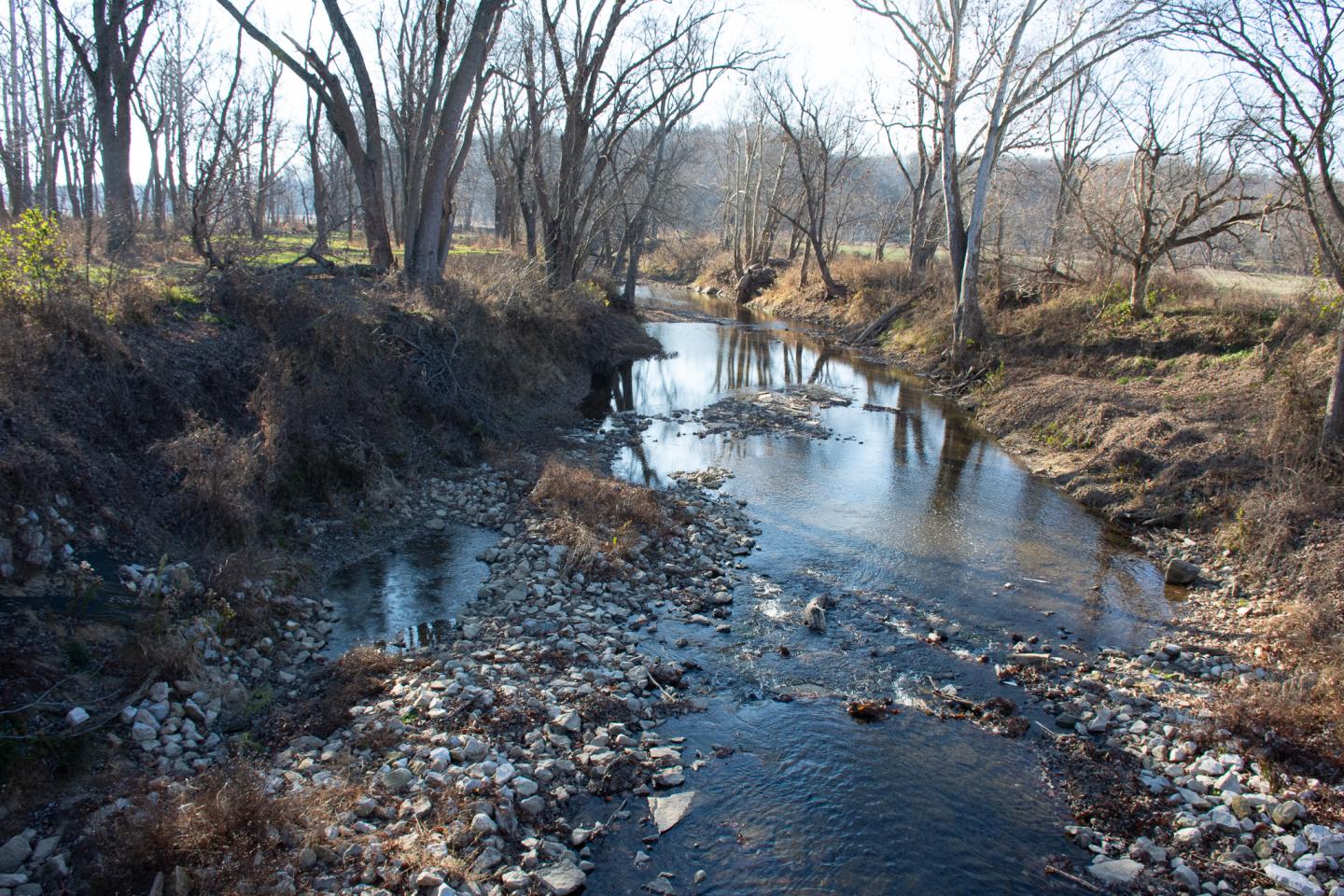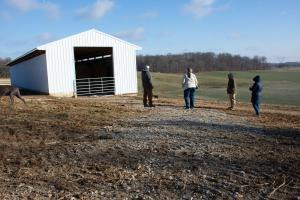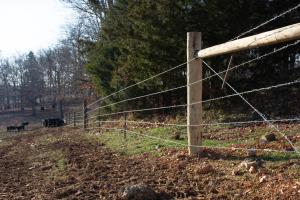Landowner Helps Save the Blue River

The National Water Quality Initiative (NWQI) provides a way to accelerate voluntary, on-farm conservation investments and focused water quality monitoring and assessment resources.
The Blue River can be found flowing through 81,000 acres of gently rolling farmland and karst topography in Washington County, Indiana. For landowners in the watershed like Todd Armstrong, protecting this valuable resource is a priority. This watershed is important to Armstrong not only because it includes special memories from his childhood, but it is also home to significant wildlife habitat, vast aquifers which supply clean drinking water and incredible recreation.

Known for its scenery, the Blue River is a main destination in Southern Indiana for canoeing and kayaking. It also supports a wide variety of fish and birds, including the bald eagle and nearby caves are home to the Indiana Bat, an endangered species. Most recently, a juvenile Eastern Hellbender, about two and a half inches long, was found in the Blue River. The largest salamanders in the U.S., hellbenders have been on the decline in the state since the mid-1900s and are currently listed as endangered in Indiana. The Eastern Hellbender thrives in swift moving clear streams with large flat rocks where accumulating sediment is not a concern, this latest discovery is a sure-tell sign that the water quality in the Blue River is improving.
“We canoe on Blue River, we play in the river, we fish in the river. And I’ve been doing that ever since I could walk,” said Armstrong. “So, we want it protected and we want it to be accessible to the public.”
Armstrong not only grew up playing in the Blue River, but he is also acquiring the family farm from his father runs adjacent to the river. Purchased by the family in 1813, this makes it one of the oldest farms in the state that’s homesteaded. While it’s been pieced up over the years, Armstrong’s father still maintains 70 acres of the original property’s 600 acres. In addition to the 70 acres, Armstrong now farms an additional 850 acres of row crops and another 200 acres of hay and pastureland in the Blue River watershed.
“We also have 100-head brood cows. We do cow-calf and then we sell breeding stock. We sell a lot of bulls, breeding heifers, and then also freezer beef.”
His love for the river and growing up on the family farm helped Armstrong become the conservationist he is today. His father signed the farm’s first Natural Resources Conservation Service (NRCS) conservation planning contract on the land in 2002, where he installed several conservation practices to improve his pastureland.

“I think that’s the key to conservation, at least it seems to be in this county. A lot of it is handed down from one generation to the next,” said Armstrong.
Funding Farm Bill contracts has always been difficult in Washington County. Within the past 10 years, as farmers began seeing the benefits of the soil health movement and the possibilities of bettering their land and operation with the addition of conservation practices, more and more landowners were coming into the NRCS office to sign up for financial assistance, making funding much more difficult. As an SWCD board member and a farmer, Armstrong recognized how difficult it was to get an application funded through a statewide program.
“We were seeing about 30 to 50 percent of our Environmental Quality Incentives Program applications getting funded,” said former Washington County District Conservation Ruth Hackman. “Our landowners were getting frustrated because many applied multiple times and wouldn’t get funded.”
With the help of his fellow board members and Hackman, the Washington County Soil and Water Conservationist District (SWCD) sought additional forms of funding for the watershed. They first sought out Indiana Department of Environmental Management (IDEM) 319 funding and completed a watershed management plan.
“This plan allowed them to apply for another 319 grant to put conservation practices on the ground, but it also opened up the doors for additional funding like NWQI,” said Hackman. “I feel really good that the board recognized these issues and took extra steps to make it happen.”

The National Water Quality Initiative (NWQI) is a targeted funding pool within the Environmental Quality Incentives Program (EQIP) – NRCS’ flagship conservation program. The initiative is unique because it consists of a partnership between NRCS, state water quality agencies and the U.S. Environmental Protection Agency to identify and address impaired water bodies through voluntary conservation. It provides targeted funding for financial and technical assistance in small watersheds most in need, like Blue River, and where farmers can use conservation practices to make a difference. State water quality agencies and other partners like the SWCD contribute additional resources for watershed planning, implementation and outreach.
“Having NWQI in our area is special. By having the NWQI pot of money, our landowners are competing against less people. They’re only competing against people in the watershed,” said Hackman. “We knew it would bring in extra money, but we didn’t realize 100% of our applications were going to get funded.”
The county has seen incredible success over the past three years with NWQI, investing close to two million dollars and putting conservation practices on more than 15,500 acres within the watershed. Armstrong has been one of those landowners able to take advantage of NWQI funding, installing a suite of conservation practices including no till, cover crops, nutrient management, pest management, heavy use area protection, access roads, livestock water, roofs and covers, filter strips, critical area planting, fencing and conservation cover.

“We don’t have a ton of acres, so improving the land that we have is my way of making us more profitable,” said Armstrong. “The best asset that we have is the ground so it’s important to keep it in good condition.”
Armstrong says most organic matter in watershed typically runs between 1% and 2%, but they’ve seen an increase where they’ve been implementing cover crops, nutrient management and no-till, and have raised organic matter to between 4% and 6% among almost all their land as part of a soil health system. The increased organic matter of the soils is allowing for better infiltration of water on his cropland and pastureland acres. He is keeping sediment out of the river as the land is a lot less erosive because of this complete soil health system.
He mentioned his neighbors are even taking notice.
“The water holding capacity and tilth of the ground has just improved so much and my neighbors have even seen that,” said Armstrong. “Neighbors that worked ground every year have stopped and started incorporating cover crops because they’ve seen how good it has worked for us.”
Armstrong hopes the conservation legacy continues to grow not only in the county but also with his family. His three sons are helping with the family business and are even farming their own ground throughout the watershed. And who knows, maybe one day, Armstrong will have grandkids that will also find joy in playing in and protecting the Blue River.

